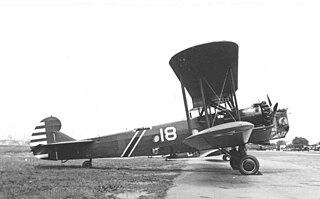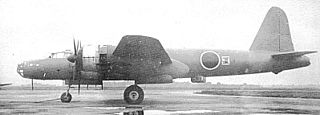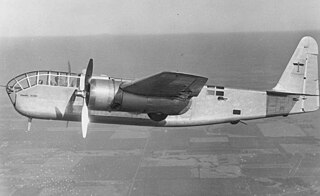Related Research Articles

The Blohm & Voss BV 138Seedrache, but nicknamed Der Fliegende Holzschuh was a World War II German trimotor flying boat that served as the Luftwaffe's main seaborne long-range maritime patrol and naval reconnaissance aircraft.

The Keystone B-6 was a biplane bomber developed by the Keystone Aircraft company for the United States Army Air Corps.

The Douglas XB-19 was the largest bomber aircraft built for the United States Army Air Forces until 1946. It was originally given the designation XBLR-2.
The Boeing Y1B-20 was designed as an improvement on the Boeing XB-15 It was slightly larger than its predecessor, and was intended to use much more powerful engines. It was presented to the Army in early 1938, and two orders were placed soon after. The order was reversed before construction began.

The AEG D.I was a biplane fighter of World War I. Three prototypes were ordered, but after the first two were involved in serious crashes, one of which killed flying ace Walter Höhndorf on September 5, 1917, development was cancelled. A triplane version was built as the Dr.I. The second and third prototypes differed little from the first except in detail.

The AEG G.II was a German biplane bomber aircraft of World War I developed from the AEG G.I, with more powerful engines. The G.II was typically armed with three 7.92 mm (.312 in) machine guns and 200 kg (440 lb) of bombs. The bomber suffered stability problems, and many G.IIs were fitted with additional vertical tail surfaces on each side of the fin and rudder to improve flight handling characteristics.

The Aero A.29 was a military biplane developed in Czechoslovakia from the ubiquitous Aero A.11 reconnaissance-bomber. Aero equipped it with floats and it served as a target tug for training anti-aircraft gunners.

The Nakajima G8N Renzan was a four-engine long-range bomber designed for use by the Imperial Japanese Navy. The Navy designation was "Type 18 experimental land-based attack aircraft" (十八試陸上攻撃機); the Allied code name was "Rita".
The Martin XB-33 Super Marauder was a proposed World War II American bomber aircraft. It was designed by the Glenn L. Martin Company as the Martin Model 190 and was a high-altitude derivative of the company's B-26 Marauder. Two different designs were developed, first as a twin-engined aircraft and then as a four-engined aircraft. The four-engined version was ordered by the United States Army Air Forces, but the program was cancelled before any aircraft were built.
The Martin XB-68 was a supersonic medium tactical bomber with a crew of two that was proposed in 1954 to the United States Air Force. The project, however, was canceled before any aircraft were built.

The Martin Model 167 Maryland was an American-designed light bomber that first flew in 1939. It saw action in World War II with France and the United Kingdom.

The Vultee XP-68 Tornado was proposed American high-altitude interceptor aircraft. It was based on the experimental XP-54 Swoose Goose and powered by the Wright R-2160 Tornado 42-cylinder radial engine driving a set of contra-rotating propellers in a twin-boom pusher configuration. When the engine was cancelled on 22 November 1941, the XP-68 was also cancelled.

The Stearman XA-21 was a competitor in a United States Army Air Corps competition for a twin-engined attack aircraft which led to the Douglas A-20 Havoc, Martin A-22 Maryland and North American B-25 Mitchell.

The Douglas A-33 was an American attack aircraft built in small numbers during World War II. It was an updated version of the Northrop A-17, with a more powerful engine and an increased bomb load. While the A-33 was intended initially for the export market, the entire production run was taken up by the United States Army Air Corps.
The Arado Ar 195 was a single-engine prototype carrier-based torpedo bomber, built by the German firm Arado for service on the German aircraft carrier Graf Zeppelin, during World War II.

The Heinkel HE 8 was a reconnaissance floatplane built in Germany in the late 1920s. It was developed at the request of the Danish Navy, which had noted the success of the HE 5 in Swedish service, and wished to purchase a similar aircraft as well as licensed production as the Orlogsvaerftet HM.II. Apart from its new Armstrong Siddeley engine, the HE 8 also differed from the HE 5 and previous members of the HE 1 family in having a conventional empennage. 22 aircraft were operated until the German invasion in 1940, after which one example was impressed into Luftwaffe service and the remainder placed in storage.

The Sikorsky S-31 was a 1920s American sesqiuplane designed and built by the Sikorsky Manufacturing Corporation and configured for aerial photography.
The Ilyushin DB-4 or TsKB-56 was a Soviet twin-engined bomber aircraft of the early 1940s. It was a development of the Ilyushin DB-3 and was intended as a replacement for the earlier aircraft, but only two prototypes were built; engine problems and the need to concentrate production on existing types following the German invasion of the Soviet Union in June 1941 meant that no more examples were built.
The Zeppelin-Lindau C.II was a German single-engine two-seat biplane built by Zeppelin-Lindau during World War I.
The Mitsubishi G7M Taizan was a proposed twin-engine long-range bomber designed for use by the Imperial Japanese Navy in 1941.
References
- 1 2 Wagner, Ray. American Combat Planes of the 20th Century: A Comprehensive Reference. Reno, Nevada: Jack Bacon & Co, 2004. ISBN 0-930083-17-2.